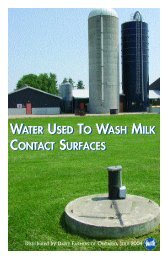Canadian Quality Milk On-Farm Food Safety Program - Centre ...
Canadian Quality Milk On-Farm Food Safety Program - Centre ...
Canadian Quality Milk On-Farm Food Safety Program - Centre ...
Create successful ePaper yourself
Turn your PDF publications into a flip-book with our unique Google optimized e-Paper software.
<strong>Canadian</strong> <strong>Quality</strong> <strong>Milk</strong><br />
• Clean residue from milk contact services according to guidelines set out by the<br />
service dealer, milk regulatory authority or refer to chart “Troubleshooting Films<br />
and Deposits on Equipment” in Chapter 11.<br />
• Review and revise SOP control measures to avoid a reoccurrence.<br />
• The following procedure can be used to remove the old build-up of fat, mineral,<br />
and protein on your CIP system during the wash cycle:<br />
Step 1.<br />
Step 2.<br />
Let the system go through the hot wash cycle, doubling the<br />
amount of detergent and adding the same amount of<br />
chlorine sanitizer.<br />
Reset the system to a second hot wash cycle, but replace<br />
the detergent by three times the normal acid amount.<br />
If equipment is still not clean, the process may have to be repeated.<br />
Remember: the sanitizer can only be mixed with the alkaline cleaner ⎯<br />
never with the acid.<br />
NOTE: After repeated exposure to high concentrations of detergent, rubber parts<br />
(i.e. liners) may have to be replaced. High chlorine content breaks down the inner<br />
protective coat of the liner.<br />
NOTE: Be vigilant in ensuring that the hot water system can deliver sufficient hot<br />
water to complete the above procedure.<br />
Reminder: All problems that occur regarding equipment sanitation and<br />
the corrective actions taken must be recorded on Record 13 or Record 17<br />
in the Workbook.<br />
See Chapter 7, Section 7.1 for more information on equipment sanitation.<br />
9.4.5 Water Temperature<br />
You must have a written corrective action plan for improper water temperature. Some<br />
possible actions are:<br />
• Check hot water heater to ensure it is functioning (e.g. one element may be<br />
burned out, faulty thermostat).<br />
• Check if the bulk tank was previously washed; thereby, exhausting the hot water<br />
tank and using all of the available hot water. If this is the case, wait and then rerun<br />
the wash cycle and check to make sure the temperature is adequate.<br />
• Check electrical breakers<br />
• Repair or replace hot water heater.<br />
• If the water heater works normally, call an equipment dealer to have the valves<br />
within the washer checked.<br />
June 2010 9—7
















